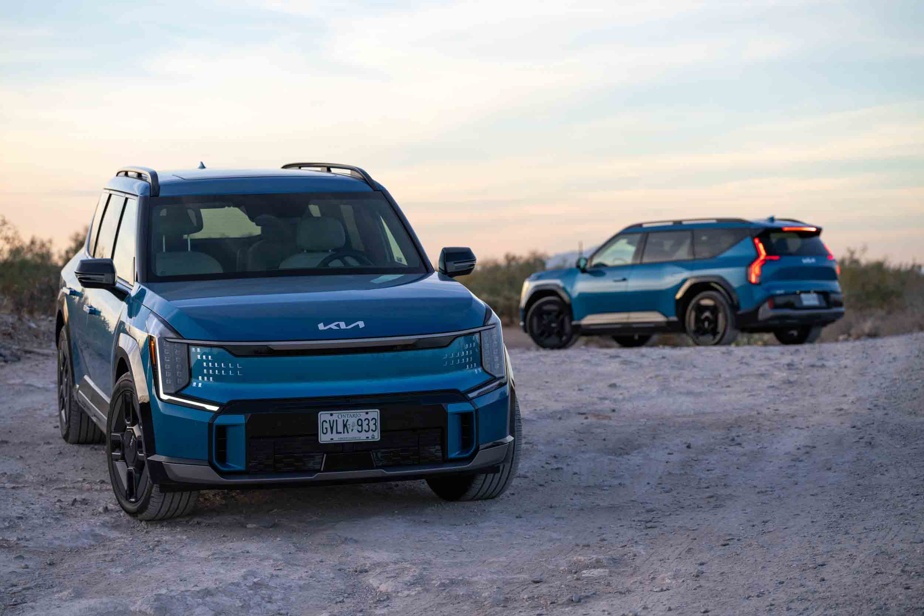(Sedona, Arizona) Should we jump at the first opportunity we get? Kia is the first traditional manufacturer to offer a utility vehicle capable of carrying seven people on board without emitting a single gram of CO2. The offer is tempting as hell. But looking closer, we still wonder a little.
The style studies concocted by manufacturers are less and less futuristic devices with no future. Kia, for one, still provides proof of this. So the EV9 concept revealed at the 2021 Los Angeles Auto Show was far from a free exercise. It openly foreshadowed the final version of the EV9 that you have before your eyes today.
Designed under the direction of Montreal stylist Karim Habib, the EV9 looks like a brick. However, this one is more slender than it appears. The Kia EV9 claims an astonishing 0.28 aerodynamic drag coefficient, the same as the EV6. The secret lies in the attention paid to details, in the movable awnings (see the video) and the design of the plastic hubcaps… Never mind the function for which the EV9 (seven seats) is intended, without forgetting the mass he has to move still represents a handicap. Air resistance largely determines the autonomy of such a vehicle. This constraint, like the need to shed weight, runs counter to the hegemony of current SUVs, which are often pachydermic. The question that kills now: do you really need it? If so, be aware that to take advantage of all the prowess and little treats that the EV9 boasts, it’s expensive. The idea of paying some $80,000 for the most capable EV9 makes many critics chuckle. They like to point out that it’s a Kia… True, but this comment also applies to many other general brands, doesn’t it?
Kia sets the EV9’s starting price at $59,995. In exchange for this sum, the consumer is entitled to the Light version. It lives up to its name, as it is light in the figurative sense of the term. It only drives its rear wheels (propulsion) via a motor (201 horsepower) powered by a 76.1 kWh battery. Under optimal conditions, the assumed range is 370km (but recharges rather quickly at a suitable station), and the permitted towing capacity is 454kg. The heat pump, considered essential for our climate, is conspicuous by its absence. To put it bluntly, this “lite” version inspires distrust and seems to have no sole purpose in cracking government safes.
If you choose the EV9, make an appointment with one of the other two versions in its catalog (Wind and Land). Both benefit from a heat pump, a higher density battery (99.8 kWh), and they easily cover 400 km without having to stop at a terminal. Unless four-wheel drive (all-wheel drive) and towing capacity are high on your list of criteria, the Wind appears to be the better deal on paper. During the media launch, only the Land GT-Line version ($78,995) was available to the journalists present. An opportunity to discover the advances of this model, but it raises questions about the dynamic performance of the different versions. We are specifically thinking of the adjustable rear suspension, exclusive to buyers of the GT-Line option group. This not only contributes to making the vehicle more pleasant in a towing situation, but also contributes to stability and comfort. How compared to the “conventional” suspension of other EV9s? Impossible to answer with conviction. On the other hand, when questioned on this subject, one of those responsible for its development admits that agility is less and that the EV9 absorbs road deformations more harshly.
In the configuration tested, the EV9 invites calm. Rushing him won’t help. This only exposes his clumsy behavior. When you take a more leisurely approach, the EV9 proves more predictable. Sufficiently precise, its steering rolls through turns gently, and the velocity of its propeller allows it to be pulled out with force. The suspension handles unevenness flexibly, and the braking is powerful – easy to modulate too – to stop this behemoth of more than 2.5 tonnes over short distances. On a daily basis, driving the EV9 allows the use of only one pedal (accelerator). As for the four-wheel drive, it proves effective, but the low ground clearance of this vehicle hardly encourages you to go off the beaten track.
Just like a minivan, you don’t buy an EV9 for the pleasure of driving, but to travel with your tribe. Both the exterior and interior dimensions of the EV9 are approximately the same as those of the Telluride (a gasoline SUV from Kia). This is a bit surprising given that an electric vehicle, provided it has its own technical base (this is the case here), offers a much more spacious interior for comparable dimensions. Will Hyundai and Genesis (see our boxes) achieve better results?
In its most elitist version, we appreciate the variety of materials (colors, textures), but we are sad to see the lack of rigor in terms of ergonomics. The positioning of the gear selector (behind the steering wheel), its handling (the reverse order of gears: D-N-R rather than R-N-D) and the contact button (accessibility) are all irritants. In addition, the steering wheel rim partially obscures the air conditioning and heating pictograms printed on the infotainment screen. Why so much extravagance? The public only asked for an electric family vehicle. And ideally, at an affordable price. Will competition, because there will be some, be able to fully grant this wish?
